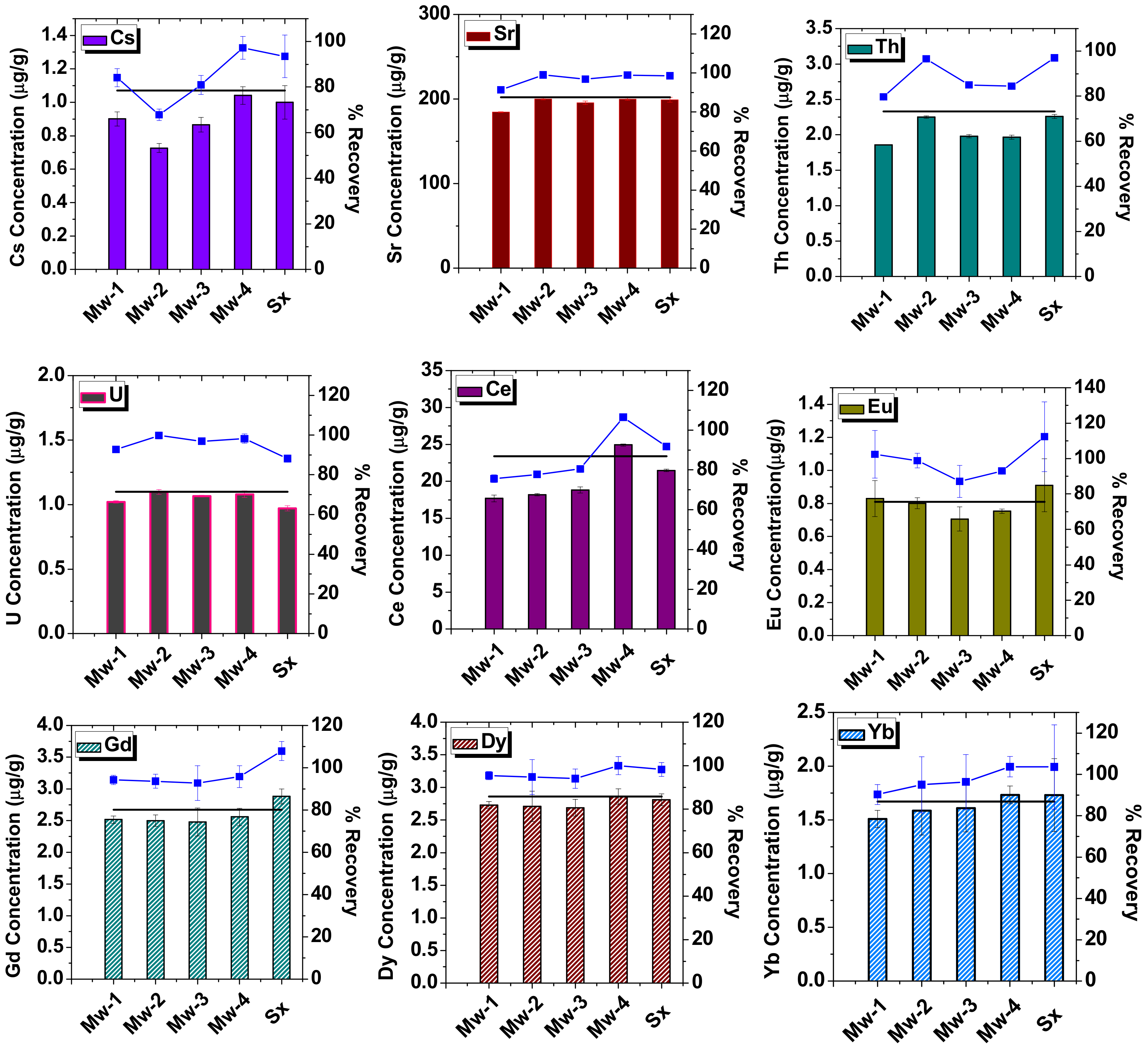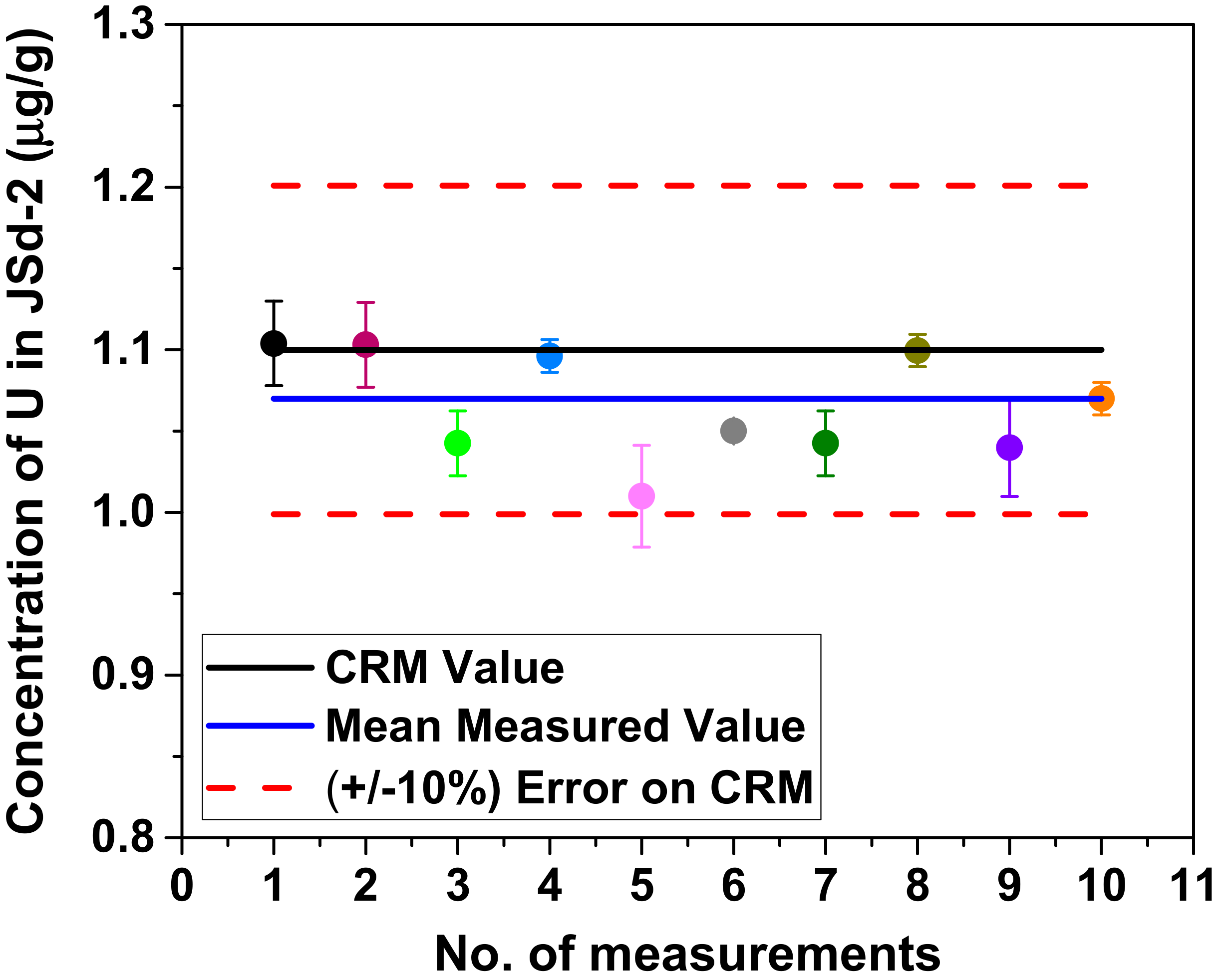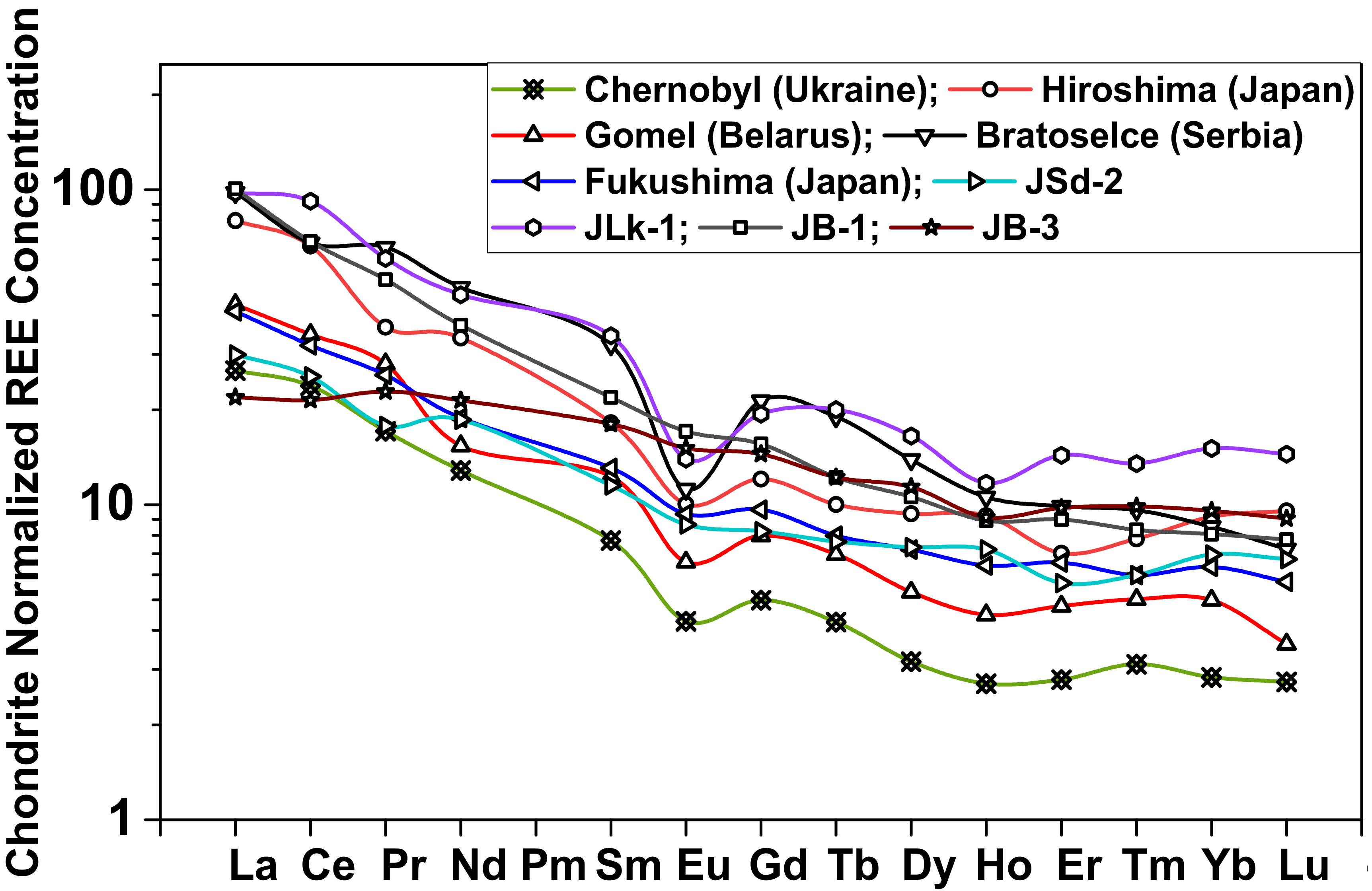A Microwave Digestion Technique for the Analysis of Rare Earth Elements, Thorium and Uranium in Geochemical Certified Reference Materials and Soils by Inductively Coupled Plasma Mass Spectrometry
Abstract
1. Introduction
2. Results and Discussion
2.1. Comparison between Digestion Methods for JSd-2
2.2. Rare Earth Elements and Selected Elements in Certified Reference Materials
2.3. Analysis of REEs, Th and U in Soils from Different Countries
3. Materials and Methods
3.1. Reagents and Chemicals
3.2. Samples and Sampling Locations
3.3. Sample Preparation
3.3.1. Microwave Digestion (Mw)
3.3.2. Savillex Digestion (Sx)
3.4. ICP-MS Measurements
4. Conclusions
Author Contributions
Funding
Conflicts of Interest
References
- World Health Organization. A Global Overview of National Regulations and Standards for Drinking-Water Quality; WHO: Geneva, Switzerland, 2018; ISBN 978-92-4-151376-0. [Google Scholar]
- United Nations Scientific Committee on the Effects of Atomic Radiation. Sources and Effects of Ionizing Radiation; United Nations Scientific Committee on the Effects of Atomic Radiation: New York, NY, USA, 2008; ISBN 978-92-1-142280-1. [Google Scholar]
- Ministry of Education, Culture, Sports, Science and Technology-Japan. Monitoring Information of Environmental Radioactivity Level; Ministry of Education, Culture, Sports, Science and Technology: Tokyo, Japan, 2011. Available online: http://radioactivity.mext.go.jp/ja (accessed on 13 July 2020).
- The United Nations Environment Programme. Depleted Uranium in Kosovo: Post-Conflict Environmental Assessment; The United Nations Environment Programme: Nairobi, Kenya, 2001; Available online: https://www.unenvironment.org/resources/report/depleted-uranium-kosovo-post-conflict-environmental-assessment (accessed on 16 June 2020).
- Steinhauser, G.; Brandl, A.; Johnson, T.E. Comparison of the Chernobyl and Fukushima nuclear accidents: A review of the environmental impacts. Sci. Total Environ. 2014, 470, 800–817. [Google Scholar] [CrossRef] [PubMed]
- Sahoo, S.K.; Fujimoto, K.; Čeliković, I.; Ujić, P.; Žunić, Z.S. Distribution of uranium, thorium, and isotopic composition of uranium in soil samples of south Serbia: Evidence of depleted uranium. Nucl. Technol. Radiat. Prot. 2004, 19, 26–30. [Google Scholar] [CrossRef]
- Potts, P.J.; Thorpe, W.O.; Isaacs, M.C.; Wright, D.W. High-precision instrumental neutron-activation analysis of geological samples employing simultaneous counting with both planar and coaxial detectors. Chem. Geol. 1985, 48, 145–155. [Google Scholar] [CrossRef]
- Yenisoy-Karakaş, S.; Gaga, E.O.; Doğangün, A.; Tuncel, S.G. Determination of major and rare earth elements in Bastnasite Ores by ICP-AES. Anal. Lett. 2004, 37, 2701–2709. [Google Scholar] [CrossRef]
- Zhu, Z.; Zheng, A. Fast determination of yttrium and rare earth elements in seawater by inductively coupled plasma-mass spectrometry after online flow injection pretreatment. Molecules 2018, 23, 489. [Google Scholar] [CrossRef]
- Lee, S.G.; Kim, T.; Tanaka, T.; Lee, S.R.; Lee, J.I. Effect on the measurement of trace element by pressure bomb and conventional Teflon vial methods in the digestion technique. J. Petrol. Soc. Korea 2016, 25, 107–119. [Google Scholar] [CrossRef]
- Kon, Y.; Hirata, T. Determination of 10 major and 34 trace elements in 34 GSJ geochemical reference samples using femtosecond laser ablation ICP-MS. Geochem. J. 2015, 49, 351–375. [Google Scholar] [CrossRef]
- Sindern, S. Analysis of rare earth elements in rock and mineral samples by ICP-MS and LA-ICP-MS. Phys. Sci. Rev. 2017, 2, 20160066. [Google Scholar] [CrossRef]
- Smith, F.E.; Arsenault, E.A. Microwave-assisted sample preparation in analytical chemistry. Talanta 1996, 43, 1207–1268. [Google Scholar] [CrossRef]
- Makishima, A. Thermal Ionization Mass Spectrometry (TIMS): Silicate Digestion, Separation, Measurement; John Wiley & Sons: Weinheim, Germany, 2016; pp. 41–90. [Google Scholar]
- Namieśnik, J.; Zygmunt, B. Role of reference materials in analysis of environmental pollutants. Sci. Total Environ. 1999, 228, 243–257. [Google Scholar] [CrossRef]
- Kasar, S.; Mishra, S.; Omori, Y.; Sahoo, S.K.; Kavasi, N.; Arae, H.; Sorimachi, A.; Aono, T. Sorption and desorption studies of Cs and Sr in contaminated soil samples around Fukushima Daiichi Nuclear Power Plant. J. Soils Sediments 2020, 20, 392–403. [Google Scholar] [CrossRef]
- Mishra, S.; Arae, H.; Zamostyan, P.V.; Ishikawa, T.; Yonehara, H.; Sahoo, S.K. Sorption-desorption characteristics of uranium, cesium and strontium in typical podzol soils from Ukraine. Radiat. Prot. Dosim. 2012, 152, 238–242. [Google Scholar] [CrossRef]
- Imai, N.; Terashima, S.; Itoh, S.; Ando, A. Compilation of analytical data on nine GSJ geochemical reference samples, “Sedimentary rock series”. Geostand. Newsl. 1996, 20, 165–216. [Google Scholar] [CrossRef]
- Sahoo, S.K.; Hosoda, M.; Kamagata, S.; Sorimachi, A.; Ishikawa, T.; Tokonami, S.; Uchida, S. Thorium, uranium and rare earth elements concentration in weathered Japanese soil samples. Prog. Nucl. Sci. Technol. 2011, 1, 416–419. [Google Scholar] [CrossRef]
- Sahoo, S.K.; Hosoda, M.; Prasad, G.; Takahashi, H.; Sorimachi, A.; Ishikawa, T.; Tokonami, S.; Uchida, S. Naturally occurring radionuclides and rare earth elements in weathered Japanese soil samples. Acta Geophys. 2013, 61, 876–885. [Google Scholar] [CrossRef]
- Bürger, S.; Mathew, K.J.; Mason, P.; Narayanan, U. Reference materials characterized for impurities in uranium matrices: An overview and re-evaluation of the NBL CRM 124 series. J. Radioanal. Nucl. Chem. 2009, 279, 659–673. [Google Scholar] [CrossRef]
- Schappert, M.; Montoya, D.; Aragon, S.; Rearick, M.; Xu, N.; Mathew, K.J. Combining accuracy and precision of traceable standards to estimate uncertainties in trace element content measurements. J. Radioanal. Nucl. Chem. 2018, 318, 323–330. [Google Scholar] [CrossRef]
- ISO. Guide to the Expression of Uncertainty in Measurement, 1st ed.; International Standards Organization ISO: Geneva, Switzerland, 1995; ISBN 92-67-10188-9. [Google Scholar]
- Yamamoto, K.; Yamashita, F.; Adachi, M. Precise determination of REE for sedimentary reference rocks issued by the Geological Survey of Japan. Geochem. J. 2005, 39, 289–297. [Google Scholar] [CrossRef]
- Liu, S.; Zhang, H.; Zhu, A.; Wang, K.; Chen, M.-T.; Khokiattiwong, S.; Kornkanitnan, N.; Shi, X. Distribution of rare earth elements in surface sediments of the western Gulf of Thailand: Constraints from sedimentology and mineralogy. Quat. Int. 2019, 527, 52–63. [Google Scholar] [CrossRef]
- Yegorova, T.P.; Starostenko, V.I.; Kozlenko, V.G.; Yliniemi, J. Lithosphere structure of the Ukrainian Shield and Pripyat Trough in the region of EUROBRIDGE-97 (Ukraine and Belarus) from gravity modelling. Tectonophysics 2004, 381, 29–59. [Google Scholar] [CrossRef]
- Dragović, S.; Janković-Mandić, L.; Dragović, R.; Đorđević, M.; Đokić, M.; Kovačević, J. Lithogenic radionuclides in surface soils of Serbia: Spatial distribution and relation to geological formations. J. Geochem. Explor. 2014, 142, 4–10. [Google Scholar] [CrossRef]
- Geological Survey of Japan Home Page. Available online: https://www.gsj.jp/en/index.html (accessed on 15 September 2020).
- Rudnick, R.L.; Gao, S. Composition of the continental crust. Treatise Geochem. 2003, 3, 1–64. [Google Scholar] [CrossRef]
- Shulmeister, J.; Short, S.A.; Price, D.M.; Murray, A.S. Pedogenic uranium/thorium and thermoluminescence chronologies and evolutionary history of a coastal dunefield, Groote Eylandt, northern Australia. Geomorphology 1993, 8, 47–64. [Google Scholar] [CrossRef]
- Boulyga, S.F.; Becker, J.S. Determination of uranium isotopic composition and 236U content of soil samples and hot particles using inductively coupled plasma mass spectrometry. Fresenius’ J. Anal. Chem. 2001, 370, 612–617. [Google Scholar] [CrossRef]
Sample Availability: Samples of the compounds are available from the authors. |




| Element | JSd-2 | JLk-1 | ||||||
| Mean (μg/g) | SD | CV (μg/g) | Ratio | Mean (μg/g) | SD | CV (μg/g) | Ratio | |
| La | 10.56 | 0.97 | 11.30 | 0.93 | 37.98 | 3.36 | 40.60 | 0.93 |
| Ce | 21.68 | 1.97 | 23.40 | 0.93 | 89.79 | 1.12 | 87.90 | 1.02 |
| Pr | 2.43 | 0.17 | 2.40 | 1.01 | 8.23 | 0.06 | 8.53 | 0.96 |
| Nd | 12.19 | 0.98 | 13.20 | 0.92 | 33.21 | 0.27 | 35.70 | 0.93 |
| Sm | 2.55 | 0.11 | 2.68 | 0.95 | 7.91 | 0.12 | 7.87 | 1.00 |
| Eu | 0.82 | 0.03 | 0.81 | 1.01 | 1.21 | 0.04 | 1.27 | 0.95 |
| Gd | 2.67 | 0.07 | 2.67 | 1.00 | 6.04 | 0.07 | 6.02 | 1.00 |
| Tb | 0.43 | 0.01 | 0.44 | 0.98 | 1.18 | 0.02 | 1.23 | 0.96 |
| Dy | 2.76 | 0.11 | 2.86 | 0.97 | 6.45 | 0.17 | 6.57 | 0.98 |
| Ho | 0.64 | 0.04 | 0.68 | 0.94 | 1.04 | 0.01 | 1.06 | 0.98 |
| Er | 1.50 | 0.13 | 1.48 | 1.01 | 3.66 | 0.02 | 3.59 | 1.01 |
| Tm | 0.23 | 0.01 | 0.23 | 1.01 | 0.52 | 0.01 | 0.53 | 0.99 |
| Yb | 1.63 | 0.06 | 1.67 | 0.98 | 3.76 | 0.11 | 3.99 | 0.94 |
| Lu | 0.25 | 0.01 | 0.25 | 0.98 | 0.56 | 0.01 | 0.57 | 0.99 |
| Cs | 1.03 | 0.03 | 1.07 | 0.96 | 10.51 | 0.19 | 10.90 | 0.96 |
| Sr | 200 | 1 | 202 | 0.99 | 67.32 | 0.02 | 67.50 | 0.99 |
| Th | 2.31 | 0.15 | 2.33 | 0.99 | 18.56 | 0.96 | 19.50 | 0.95 |
| U | 1.07 | 0.03 | 1.10 | 0.97 | 3.75 | 0.01 | 3.83 | 0.98 |
| Element | JB-1 | JB-3 | ||||||
| Mean (μg/g) | SD | CV (μg/g) | Ratio | Mean (μg/g) | SD | CV (μg/g) | Ratio | |
| La | 38.06 | 0.46 | 38.60 | 0.99 | 8.29 | 0.53 | 8.81 | 0.94 |
| Ce | 66.86 | 0.55 | 67.80 | 0.99 | 20.97 | 0.15 | 21.50 | 0.97 |
| Pr | 7.05 | 0.50 | 7.01 | 1.00 | 3.11 | 0.04 | 3.11 | 1.00 |
| Nd | 26.59 | 0.45 | 26.80 | 0.99 | 15.36 | 0.32 | 15.60 | 0.98 |
| Sm | 5.04 | 0.15 | 5.13 | 0.98 | 4.15 | 0.22 | 4.27 | 0.97 |
| Eu | 1.48 | 0.03 | 1.49 | 0.99 | 1.31 | 0.04 | 1.32 | 0.99 |
| Gd | 4.85 | 0.06 | 4.90 | 0.99 | 4.50 | 0.10 | 4.67 | 0.96 |
| Tb | 0.80 | 0.03 | 0.82 | 0.97 | 0.72 | 0.02 | 0.73 | 0.98 |
| Dy | 4.13 | 0.20 | 4.14 | 0.99 | 4.44 | 0.22 | 4.54 | 0.98 |
| Ho | 0.79 | 0.02 | 0.79 | 1.00 | 0.81 | 0.03 | 0.80 | 1.01 |
| Er | 2.29 | 0.07 | 2.27 | 1.00 | 2.49 | 0.04 | 2.49 | 1.00 |
| Tm | 0.32 | 0.03 | 0.35 | 0.91 | 0.40 | 0.01 | 0.42 | 0.95 |
| Yb | 2.01 | 0.12 | 2.13 | 0.94 | 2.38 | 0.08 | 2.55 | 0.93 |
| Lu | 0.30 | 0.02 | 0.31 | 0.97 | 0.36 | 0.03 | 0.39 | 0.92 |
| Cs | 1.24 | 0.04 | 1.23 | 1.00 | 0.93 | 0.04 | 0.94 | 0.99 |
| Sr | 445 | 1 | 444 | 1.00 | 404 | 3 | 403 | 1.00 |
| Th | 9.13 | 0.06 | 9.30 | 0.98 | 1.23 | 0.02 | 1.27 | 0.97 |
| U | 1.60 | 0.03 | 1.67 | 0.96 | 0.45 | 0.01 | 0.48 | 0.94 |
| Element | Chernobyl, Ukraine | Gomel Oblast, Belarus | Bratoselce, Serbia | Hiroshima, Japan | Fukushima, Japan |
|---|---|---|---|---|---|
| La | 10.07 ± 0.23 | 16.33 ± 0.99 | 37.04 ± 2.55 | 30.17 ± 1.57 | 15.53 ± 1.17 |
| Ce | 23.31 ± 1.30 | 33.88 ± 3.21 | 66.15 ± 5.99 | 64.78 ± 4.53 | 31.29 ± 2.28 |
| Pr | 2.33 ± 0.21 | 3.81 ± 0.35 | 8.92 ± 0.83 | 4.98 ± 0.37 | 3.51 ± 0.18 |
| Nd | 9.19 ± 0.32 | 11.02 ± 0.97 | 35.06 ± 2.91 | 24.23 ± 2.24 | 13.50 ± 1.03 |
| Sm | 1.77 ± 0.11 | 2.83 ± 0.25 | 7.39 ± 0.62 | 4.19 ± 0.09 | 3.01 ± 0.14 |
| Eu | 0.37 ± 0.02 | 0.57 ± 0.03 | 0.97 ± 0.06 | 0.87 ± 0.04 | 0.81 ± 0.05 |
| Gd | 1.55 ± 0.13 | 2.48 ± 0.22 | 6.65 ± 0.61 | 3.75 ± 0.23 | 3.01 ± 0.23 |
| Tb | 0.25 ± 0.01 | 0.41 ± 0.04 | 1.12 ± 0.07 | 0.59 ± 0.02 | 0.47 ± 0.02 |
| Dy | 1.24 ± 0.05 | 2.06 ± 0.12 | 5.42 ± 0.47 | 3.65 ± 0.27 | 2.81 ± 0.03 |
| Ho | 0.24 ± 0.01 | 0.40 ± 0.03 | 0.94 ± 0.05 | 0.82 ± 0.05 | 0.57 ± 0.01 |
| Er | 0.71 ± 0.03 | 1.22 ± 0.08 | 2.52 ± 0.05 | 1.79 ± 0.16 | 1.67 ± 0.07 |
| Tm | 0.12 ± 0.01 | 0.19 ± 0.01 | 0.37 ± 0.01 | 0.32 ± 0.03 | 0.23 ± 0.01 |
| Yb | 0.70 ± 0.04 | 1.24 ± 0.05 | 2.12 ± 0.04 | 2.28 ± 0.15 | 1.58 ± 0.11 |
| Lu | 0.11 ± 0.01 | 0.14 ± 0.01 | 0.28 ± 0.01 | 0.37 ± 0.02 | 0.22 ± 0.01 |
| Th | 2.68 ± 0.21 | 4.90 ± 0.21 | 9.16 ± 0.85 | 10.21 ± 0.67 | 6.76 ± 0.58 |
| U | 1.74 ± 0.09 | 1.18 ± 0.07 | 5.76 ± 0.31 | 2.73 ± 0.13 | 1.71 ± 0.08 |
| LREE | 48.58 | 70.92 | 162.19 | 132.97 | 70.65 |
| HREE | 3.37 | 5.66 | 12.77 | 9.80 | 7.55 |
| TREE | 51.95 | 76.58 | 174.95 | 142.77 | 78.20 |
| LREE/HREE | 14.41 | 12.53 | 12.71 | 13.57 | 9.36 |
| Sample Name | (Latitude) °N | (Longitude) °E | Date of Sampling |
|---|---|---|---|
| Gomel Oblast, Belarus | 52.3922 | 29.5238 | September 1998 |
| Chernobyl, Ukraine | 51.3731 | 29.9949 | March 2001 |
| Bratoselce, Serbia | 42.3447 | 21.7560 | March 2003 |
| Hiroshima, Japan | 34.4742 | 132.4467 | April 2009 |
| Fukushima, Japan | 37.5401 | 140.8672 | October 2015 |
| Time (min) | Power (W) | T1 (°C) | T2 (°C) |
|---|---|---|---|
| 00:03:00 | 1000 | 50 | 115 |
| 00:02:00 | 0 | 30 | 115 |
| 00:20:00 | 1000 | 210 | 115 |
| 00:20:00 | 1000 | 210 | 115 |
| 00:60:00 | 0 | 30 | 30 |
| Plasma | |
| Frequency (MHz) | 27.12 |
| RF Power (kW) | 1.55 |
| Argon Flow (L/min) | |
| Plasma | 15.0 |
| Carrier | 1.0 |
| Nebulizer | Micro Mist type |
| Sampling distance (mm) | 8.0 |
| Sample uptake rate (mL/min) | 0.4 |
| Data Acquisition | |
| Mode | Peak jumping mode |
| Number of points per peak | 3 |
| Number of scan sweeps | 100 |
| Dwell time per point (s) | 0.3 |
| Scan mass range (a.m.u.) | 7–238 |
Publisher’s Note: MDPI stays neutral with regard to jurisdictional claims in published maps and institutional affiliations. |
© 2020 by the authors. Licensee MDPI, Basel, Switzerland. This article is an open access article distributed under the terms and conditions of the Creative Commons Attribution (CC BY) license (http://creativecommons.org/licenses/by/4.0/).
Share and Cite
Kasar, S.; Murugan, R.; Arae, H.; Aono, T.; Sahoo, S.K. A Microwave Digestion Technique for the Analysis of Rare Earth Elements, Thorium and Uranium in Geochemical Certified Reference Materials and Soils by Inductively Coupled Plasma Mass Spectrometry. Molecules 2020, 25, 5178. https://doi.org/10.3390/molecules25215178
Kasar S, Murugan R, Arae H, Aono T, Sahoo SK. A Microwave Digestion Technique for the Analysis of Rare Earth Elements, Thorium and Uranium in Geochemical Certified Reference Materials and Soils by Inductively Coupled Plasma Mass Spectrometry. Molecules. 2020; 25(21):5178. https://doi.org/10.3390/molecules25215178
Chicago/Turabian StyleKasar, Sharayu, Rajamanickam Murugan, Hideki Arae, Tatsuo Aono, and Sarata Kumar Sahoo. 2020. "A Microwave Digestion Technique for the Analysis of Rare Earth Elements, Thorium and Uranium in Geochemical Certified Reference Materials and Soils by Inductively Coupled Plasma Mass Spectrometry" Molecules 25, no. 21: 5178. https://doi.org/10.3390/molecules25215178
APA StyleKasar, S., Murugan, R., Arae, H., Aono, T., & Sahoo, S. K. (2020). A Microwave Digestion Technique for the Analysis of Rare Earth Elements, Thorium and Uranium in Geochemical Certified Reference Materials and Soils by Inductively Coupled Plasma Mass Spectrometry. Molecules, 25(21), 5178. https://doi.org/10.3390/molecules25215178






